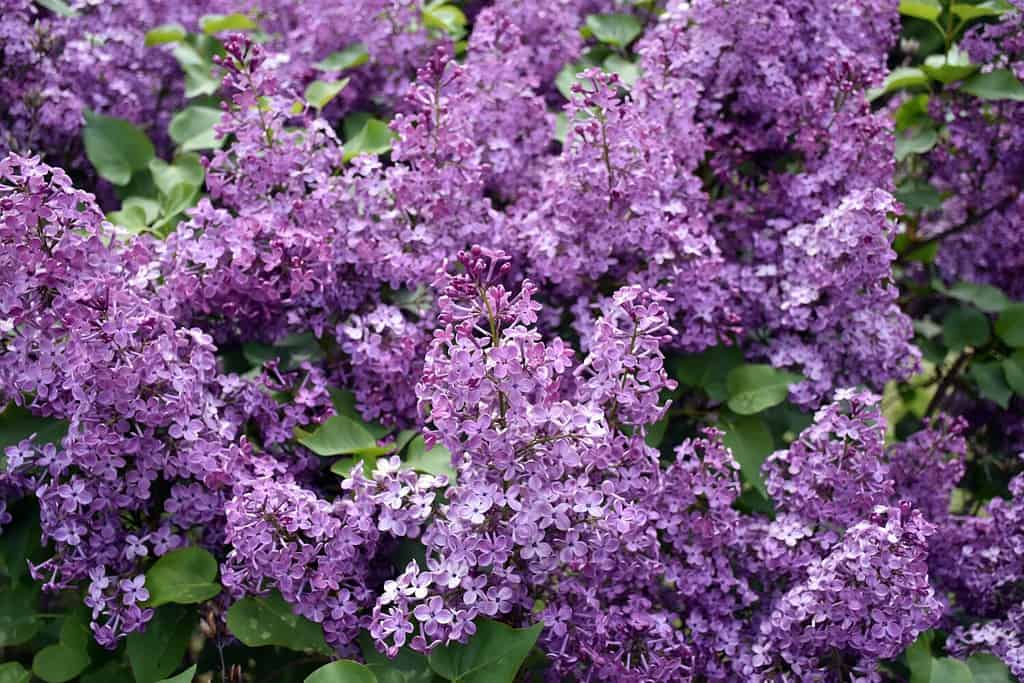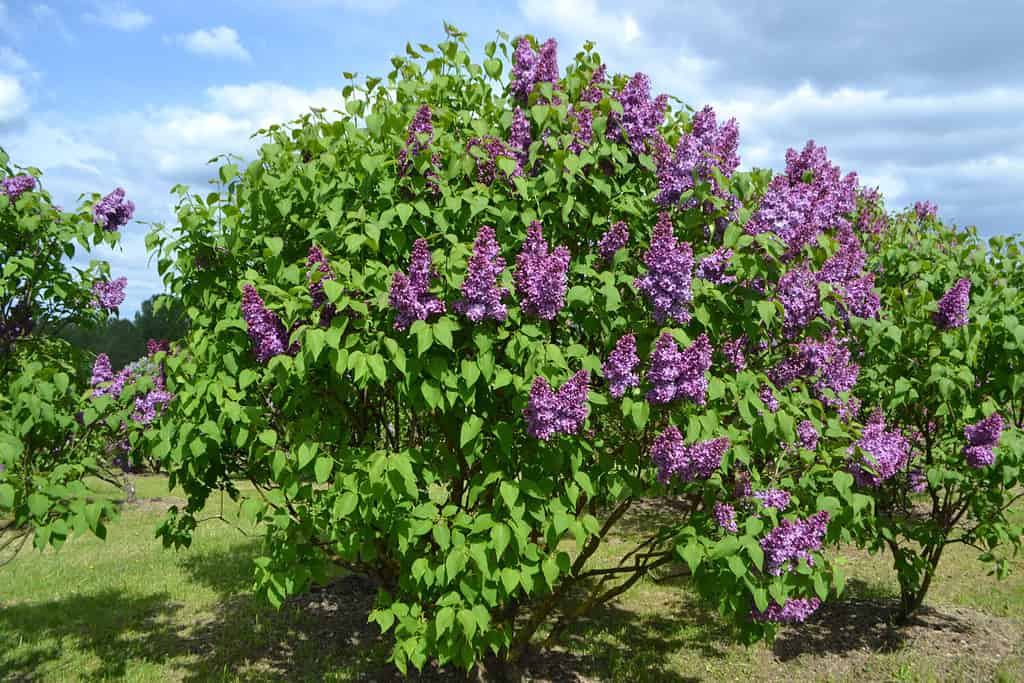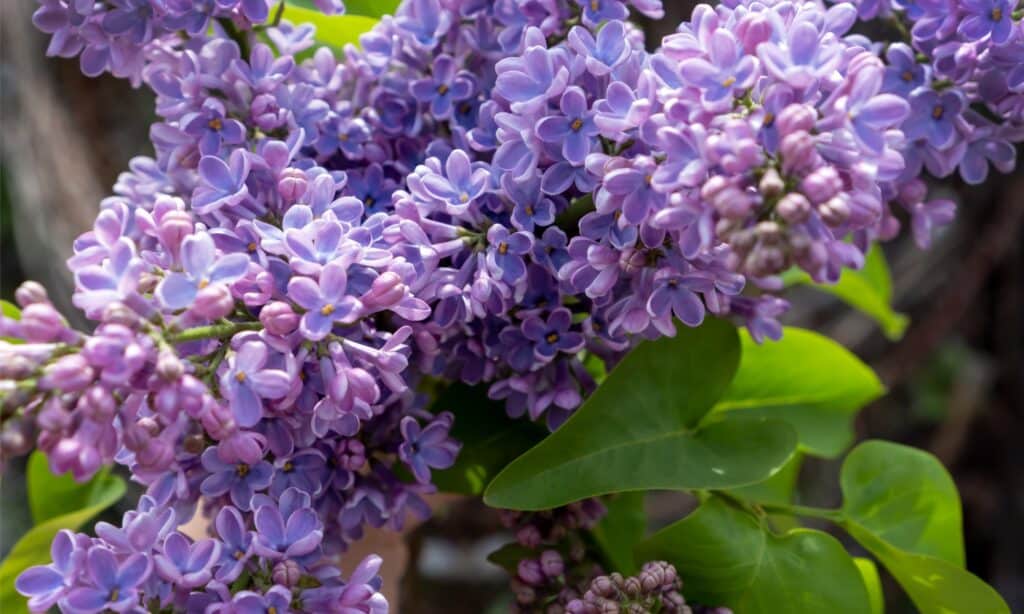Lilac shrubs are hardy perennials with lavender, white, or pink cluster flowers. They also offer a heavenly scent when in bloom! The peak season when lilacs bloom is mid-spring to early summer. However, that timing might differ where you live, depending on your local USDA Hardiness Zones. Peak lilac season can also last longer for growers of reblooming lilac varieties.
Which types of lilacs rebloom? When do lilacs bloom in your local Hardiness Zones? We answer these questions and more below, as well as how to keep your lilacs blooming for as long as possible.

Lilacs bloom in spring or summer, depending on the plant variety and cultivar.
©Joanne Dale/Shutterstock.com
Types of Lilacs and Their Bloom Timing
There are four main bloom times for lilac bushes. Each lilac cultivar falls into at least one of the following categories:
- Early Season Lilacs
- These lilacs start blooming in early to mid-spring.
- Syringa x oblata ‘Betsy Ross’ is a popular lilac cultivar with white flowers. ‘Betsy Ross’ lilacs bloom in Zones 3–8 in early spring.
- Mid-Season Lilacs
- The mid-season lilacs start blooming in late spring or early summer.
- Common lilac (Syringa vulgaris) is a highly regarded example of a mid-season shrub for Zones 3–7. It starts producing flowers in late spring.
- Late Season Lilacs
- The late-season lilacs start showing off their fluffy flowers in early to late summer.
- Syringa x prestoniae ‘Miss Canada’ is a well-loved late-season lilac that produces pink blooms by mid-summer.
- Reblooming Lilacs
- The reblooming lilac cultivars produce new flowers twice per growing season.
- Bloomerang® is a popular brand of reblooming lilacs from Proven Winners® that bloom in both spring and midsummer.
Popular Lilac Varieties
Now that we know we have options for lilac bloom timing, let’s explore some of the most popular types of lilac shrubs. Unfortunately, there are far too many types of lilac bushes to mention in one post! So, we’ll mention some of the most common varieties below.
Common lilac (Syringa vulgaris) shrubs are mid-season bloomers that thrive in Zones 3–7. They have the longest-lasting flowers compared to other lilac varieties. Their blooms can last up to an entire month! This lilac species also provides the most intense fragrance and the biggest flowers.
Chinese lilacs (S. chinensis) bloom in mid-to-late spring in Zones 3–7. They are also an 8–12 foot tall hybrid plant from a mix of common lilac and Persian lilac shrubs.
Himalayan lilac (S. villosa) bushes have fluffy blooms that resemble roses. These 10-foot shrubs are also late-bloomers that produce flowers in June and July for Zones 3–7.
Japanese tree lilacs (S. reticulata) are usually early-season shrubs that are hardy in Zones 3–7. This type of tree lilac bush produces pale yellow-white flowers and grows up to 30 feet tall.
Persian lilac (S. persica) shrubs fill with flowers in late spring for gardeners in Zones 3–7. They produce pale lavender blooms and grow up to 10 feet tall.
Lilac Peak Season By Zone
The USDA provides a Hardiness Zones map of the country for plant growers. These Zones (regions) are determined by their average lowest annual temperatures.
Plant breeders and growers use the USDA Hardiness Zones for plant selection and care. For example, we know from experienced gardeners that lilacs are cold-loving plants that struggle in hot climates. So growers in tropical climates, like Zones 9–11, might struggle to keep lilac plants alive.
See below for lilac peak season by USDA Hardiness Zone. We also provide some notes about growing lilacs in each region.
Remember that some lilac varieties bloom once, while reblooming varieties will produce flowers twice each growing season. So the cultivar you plant has a significant impact on exactly when each lilac shrub blooms.
| USDA Hardiness Zones | Lilac Peak Season | Notes |
|---|---|---|
| Zones 2a-2b | Spring, though reblooming varieties will also bloom in summer | Lilacs in Zone 2 may need extra protection from extreme cold temperatures and icy winds. |
| Zones 3a-3b | Spring, though reblooming varieties will also bloom in summer | This is an ideal Zone for lilacs. Check each cultivar’s growth habit for specific bloom timing. |
| Zones 4a-4b | Spring, though reblooming varieties will also bloom in summer | This is an ideal Zone for lilacs. Check each cultivar’s growth habit for specific bloom timing. |
| Zones 5a-5b | Spring, though reblooming varieties will also bloom in summer | This is an ideal Zone for lilacs. Check each cultivar’s growth habit for specific bloom timing. |
| Zones 6a-6b | Spring, though reblooming varieties will also bloom in summer | This is an ideal Zone for lilacs. Check each cultivar’s growth habit for specific bloom timing. |
| Zones 7a-7b | Spring, though reblooming varieties will also bloom in summer | This is an ideal Zone for lilacs. Check each cultivar’s growth habit for specific bloom timing. |
| Zones 8a-8b | Spring, though reblooming varieties will also bloom in summer | Zone 8 is likely the warmest Zone where lilac bushes can thrive as perennial plants. Check each cultivar’s growth habit for specific bloom timing. |
| Zones 9a-9b | Not recommended as plants for Zones 9 and above | Lilacs in Zone 9 and above might not survive the highest summer temperatures here. They also might not experience enough weeks of cold dormancy to produce new blooms next year. |
Now let’s discuss some common reasons why your lilac bushes might not bloom at all.

Lilacs usually produce the most blooms in USDA Hardiness Zones 3-7.
©Edita Medeina/Shutterstock.com
Why didn’t my lilacs bloom?
If your lilac bushes fail to produce flowers for a year or two, it’s time to troubleshoot the problem.
According to The Chicago Botanic Garden, there are four main reasons why lilac bushes don’t bloom. We examine those reasons below and offer quick tips for helping lilacs blossom again.
Insufficient Sunlight
Lilacs love to bask in the sun! So, if your lilac bushes aren’t producing flowers, they may need more sunlight.
Fix-it Tips:
- Remove sun-blocking structures around your lilac shrub, if possible. Also, trim tree branches around and above lilac shrubs to let more light filter through.
- Transplant the lilac to a sunnier location. Autumn is usually the best season for transplanting lilac bushes while the plants are dormant and the ground isn’t frozen. In fact, lilacs are some of the most common shrubs that gardeners plant in October in Zones 3–7.
Waiting Too Long to Prune
Pruning lilac bushes is essential for high flower production, but so is pruning them at the right time. If you wait too long, you risk trimming away the new flower buds these plants produce in the summer for next spring’s blooms.
Fix-it Tips:
- Prune lilacs right away after the shrubs are done blooming in the spring.
- For non-blooming lilac bushes, prune them in the late spring (late May or early June).
Overgrown Shrubs
Is your lilac bush getting leggy and underproducing new flowers? And are the bottom branches bare? If so, it needs a good trimming! Overgrown lilac bushes benefit from cutting them back, sometimes drastically.
Fix-it Tips:
- Prune lilac bushes in late spring before the overgrown stems produce new flower buds in early summer.
- Cut very dense, non-blooming shrubs back to about 1 foot of growth above the ground.
Overfertilized Shrubs
Lilacs are sensitive to overfertilizing. If they receive too much nitrogen and other nutrients from fertilizer, the shrubs won’t bloom.
Here are some basic signs that your lilac bushes are overfertilized:
- Yellow or browning leaves
- Lots of foliage and very few flowers
- Dark and rotting roots
Fix-it Tips:
- Test the soil where lilacs grow for its nutrient content and pH level. Lilacs prefer a soil pH between 6.0 and 7.0. Amend the soil with fertilizer or other organic matter only if needed.

Pruning lilac bushes at the proper time this year helps them produce more blooms next year.
©NikolayTsyu/Shutterstock.com
How to prolong lilac blooms
Healthy lilac bushes produce flowers that last up to two weeks in the spring. Try our plant care tips below to make lilac blooms last as long as possible.
For long-lasting blooms on the lilac bush, follow the basic steps for growing healthy plants.
- Prune lilac bushes immediately after they stop blooming each spring. Trim back any dead or diseased branches all the way to the ground.
- Ensure lilacs get 6–8 hours of direct sun every day, and don’t overfertilize them.
For long-lasting cut lilac blooms, use a flower preservative.
- Dissolve a flower preservative in the cut flower water. Flower preservative is available from local flower shops and online retailers.
- Or make your own flower preservative at home by mixing two tablespoons of white sugar with equal parts white vinegar or lemon juice.

Peak season for lilac blooms is a delight for both the eyes and the nose because of lilac’s sweet scent.
©iStock.com/Diana Ibrasheva
Lilac blooms delight the senses every spring!
Blooming lilac bushes provide pretty, fragrant flowers to savor in the spring and summer. In addition, their wonderful smell makes lilacs deer-resistant shrubs, too.
Most lilac varieties thrive mainly in Zones 3–7, but specific cultivars can be early, mid, or late-season bloomers. In addition, some lilacs are reblooming plants! So check each lilac cultivar’s growth habit for its specific peak season.
Also, remember to prune lilac bushes immediately after their flowers die in spring. This practice helps ensure that your lilacs will produce as many blooms as possible in the next growing season.
The photo featured at the top of this post is © iStock.com/Binnerstam
Thank you for reading! Have some feedback for us? Contact the AZ Animals editorial team.






